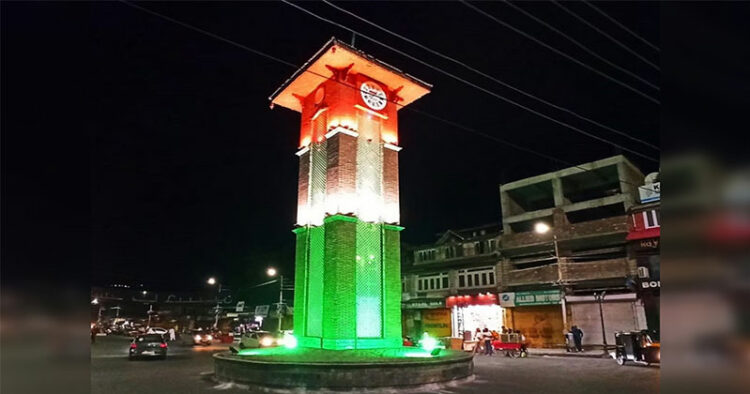The transition of Srinagar from a ravaged city into a smart city has brought the summer capital of Jammu and Kashmir (J&K) at par with the metropolitan cities in India.
It may be recalled that till August 5, 2019 when the Centre abrogated J&K’s special status and bifurcated it into two Union Territories–Srinagar was infamous for observing shutdowns, witnessing stone-pelting and separatists delivering anti-national sermons in heart of the city.
During the past three years neither Srinagar has observed a shutdown, nor has witnessed any stone-pelting incident. Neither has any separatist delivered a lecture to preach sedition, separatism and disturb the peace. Instead, the city has become vibrant and has remained abuzz with activities. It has regained its lost charisma and is all set to host G20 meetings in May this year.
As of date, over 80 construction projects are going on across the city. Srinagar is being revamped as major roads, pathways, cycle tracks and drainage systems etc are being reconstructed. Once the work is completed it would give a new look to Jammu and Kashmir’s summer capital with enhanced facilities and a clean environment.
As per the officials, the overall budget for the project is Rs 3,000 crore, of which Rs 2,000 crore has already been allocated to line departments working in collaboration with Smart City Limited on various projects, while Smart City Limited has a budget of around Rs 1,000 crore.
The project includes several pan-city projects focused on IT-related interventions, enhancing urban mobility, improving roads and upgrading public transport facilities throughout the city.
The transformation of Srinagar from a desolate city to a vibrant business hub is a sign that normalcy has returned to J&K, which witnessed Pakistan-sponsored terrorism for three long decades.
From 1990 to 2019, many encounters took place between the security forces and the terrorists in Srinagar, including Lal Chowk, the heart of the city. Terrorists left no opportunity to destroy J&K’s summer capital by carrying out suicide attacks and grenade throws at crowded places.
During the past three years, the government has embarked on the mission to erase the scars of the past as many trendy malls have come up. Old structures have been renovated and refurbished.
A peaceful and resurgent Srinagar is drawing tourists in thousands which, in turn, is giving a much-needed boost to the local economy.
The ongoing smart city project is in many ways is a step towards restoring vintage old Srinagar when all was so serene.
Notably, Srinagar earned itself a place in the UNESCO Creative Cities Network (UCCN) in the craft and folk art category in November 2021. It was the only city in India from a list of 49 worldwide to earn this honour.
Till 2021, a total of 246 cities were a part of this network. The idea is to build cities that are resilient, sustainable and future-proof. Srinagar is supporting the United Nations 2030 agenda for sustainable development at the local level.
Pertinently, for seven long decades, the concept of giving a facelift to Srinagar revolved around painting Zebra crossings, installing a few street lights here and there and repairing old footpaths. No attention was paid towards upgrading the drainage system, laying underground electricity cables and meeting other requirements.
These small repairs were carried out before the annual Durbar Move when the political rulers had to arrive in Srinagar for the summer months to run the government. The 150-year-old Durbar Move practice was introduced in 1872 by Maharaja Ranbir Singh.
The practice of government officials shifting capitals between Srinagar and Jammu for six months was scrapped by the incumbent dispensation in 2021. The practice started by a monarch was followed by the elected representatives in letter and spirit.
Former political rulers had created a notion that nothing can be done in Kashmir during winter months and moving to Jammu was the only option to run the government. But to escape the sweltering heat they used to shift from Jammu to Srinagar to work comfortably in the summer months.
During the past three years, most of the myths created by politicians have been shattered. The work on Srinagar smart city project went on smoothly in the winter season despite the temperature falling below the freezing point. Work on all the projects was carried out without any interruptions and breaks.
Srinagar by the end of April 2023 will have a New Boulevard Road–the road stretch from Dalgate to the famous Mugal Garden Nishat along the Dal Lake–it would have pathways, cycle tracks, a revamped drainage system, wifi zones and much more.
Maximum of the work on these development projects was carried out in winter and is all set to be completed in spring. Months which were declared as the most unproductive period of the year by the politicians till 2019 have turned out to be the most productive for the people of Srinagar.
Work is going on at the Polo View market in the heart of Srinagar and once it is completed the market would become the heritage market of JK’s summer capital.
The commercial centre of Srinagar city, Lal Chowk is also getting a facelift. The historic Ganta Ghar (Clock Tower) after renovation will get new time clocks, new roof decoration and new technology display for important updates.
Srinagar city, once a hotbed of terrorism, has emerged as a symbol of ‘Naya Jammu and Kashmir’ post abrogation of Article 370, a temporary provision in the Constitution.




















Comments